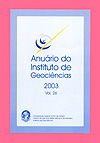Diversidade estrutural de bosques de mangue e sua relação com distúrbios de origem antrópica: o caso da Baía de Guanabara (Rio de Janeiro)
DOI:
https://doi.org/10.11137/2003_0_101-116Abstract
Structural and functional characteristics of mangrove forests are primarily governed by the interaction of environmental characteristics, that act in global, regional or local scales. However, in areas submitted to strong influence of human activities, disturbance should be considered seriously. In this way, the structural characteristics of mangroves of Guanabara bay were studied during three years (2000-2002). The studied forests presented a high structural diversity, reflecting the action of disturbances, that determine different degradation levels and regeneration status (different phases of secondary succession) of the stands. The stems density varied from zero (gaps) to 52,800 stems.ha-1. The mean diameter at breast height varied from 1.33 cm to 7.83 cm and the medium tree height varied from 1.80 m to 7.27 m. Several structural and dynamics patterns of the studied plants communities were identified, as follow: (a) reverse " j " shaped, (b) "normal" distribution, (c) mass mortality, (d) overlap of "events", (e) recolonization/gaps, (f) regeneration failure, (g) gaps and, (h) invasion by Acrostichum aureum. The high structural diversity observed in the studied forests, identified through the use of phytosociological parameters and species composition, which determines a structural mosaic, is due to the overlapping of the following characteristics: (1) variable nature of disturbances, (2) disturbances characteristics (chronic or acute), (3) spatial variability in disturbances action, (4) temporal variability in disturbances action, (5) variation in the frequency of disturbances occurrence and (6) capacity of the system to recover after a disturbance.Downloads
Published
2003-01-01
Issue
Section
Article
License
This journal is licensed under a Creative Commons — Attribution 4.0 International — CC BY 4.0, which permits use, distribution and reproduction in any medium, provided the original work is properly cited.
















 Except where otherwise noted, content on this site is licensed under a license
Except where otherwise noted, content on this site is licensed under a license 